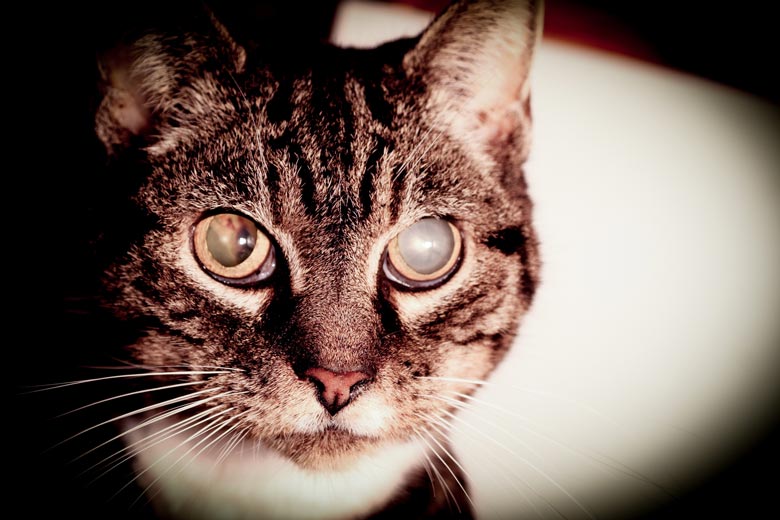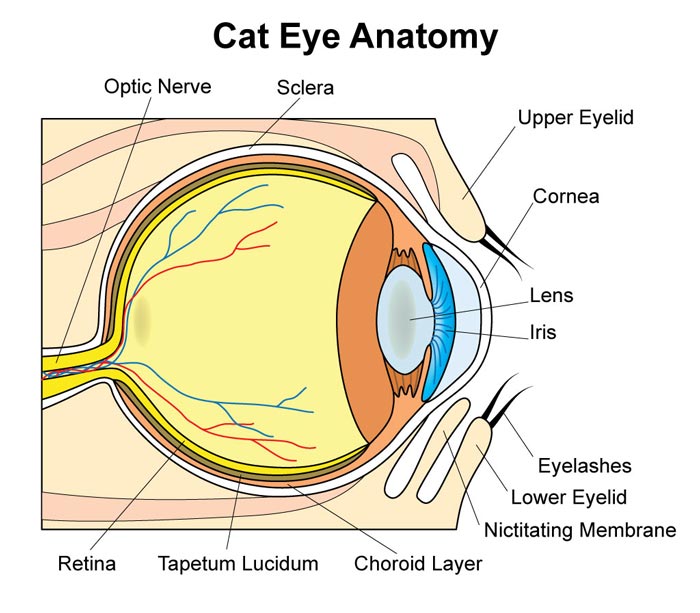Cataracts in Cats

Sight is important, and that's the case for our cats as well as ourselves. That's why it's critical to know what to watch out for that could be a danger sign that your cat is having an eye problem.
Check out this article for more information: "Eye Problems in Cats: An Overview."
Cataracts are an eye problem cats can have, and they can result in blindness.
What Are Feline Cataracts?
A cataract occurs when the lens of the eye becomes cloudy and, eventually, opaque. Normally, the lens is clear and focusses the light that enters the front of the eye onto the retina in the back, where it organizes the information and sends it to the brain, which deciphers it and makes it into a picture.

Cataracts can have a varying degree of negative impact on a cat's sight, depending on their severity and whether the cat has a cataract in one or both eyes. Cataracts cause blindness when they become so opaque and diffuse that they don't allow light to reach the retina.
What Causes Cataracts in Cats?
Cats can get a cataract any time there is damage to the lens. Here are the most common causes of cataracts in cats:
- Inflammation inside the eye, also called uveitis*
- Trauma to the eye
- Cancer
- Metabolic conditions, most commonly diabetes and high blood pressure
- Nutritional problems
- Exposure to radiation
- Certain organisms, including some bacteria, viruses, parasites, protozoa, and fungi
- Poor nutrition in kittenhood
*Uveitis can be the result of another condition and ultimately lead to an autoimmune condition where the body attacks the lens itself.
Signs of Feline Cataracts
The signs of cataracts in cats include:
- Haziness in the eye
- Trouble getting around
- Difficulty navigating stairs or transitions between differently lighted areas
- Blindness
The above signs are the result of severe cataracts. When the cataract(s) is (are) smaller or less opaque, there may not be any signs. A veterinarian can find smaller or less dense cataracts during a complete physical exam.
Diagnosis of Cataracts in Cats
Cataracts are diagnosed when a veterinarian sees them while looking into the eye with an ophthalmoscope.
After a vet diagnoses a cat with cataracts, they will generally run some other tests to look for the cause. Those can include blood work, x-rays, a urinalysis, and a fecal sample.
Treatment of Feline Cataracts
The best treatment for cataracts in cats is surgery to remove them and replace the lens with an artificial one. This procedure is done by a specialist—a veterinary ophthalmologist.
An ophthalmologist is also the best person to determine whether a kitty is a good candidate for cataract removal surgery. Underlying conditions and overall physical ability to withstand anesthesia will be taken into consideration.
There may also be a need for treatment of any underlying conditions the veterinarian finds.
Often, cats with cataracts are treated with anti-inflammatory eye drops to help prevent secondary glaucoma, which is an increased pressure that can occur if swelling of the lens obstructs normal movement and drainage of the fluid inside the eye.
You May Also Like These Articles:
Eye Problems in Cats: An Overview
Eye Infections in Young Kittens




